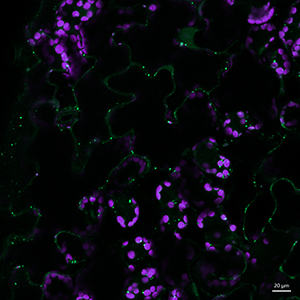How bacteria hijack the plant’s self-eating system to spread infection

A major challenge in plant breeding is the improvement of resistance to a multitude of pathogens that threaten crop productivity. Successful pathogens have evolved a large repertoire of molecular weapons, so-called ‘effectors’ that manipulate the plant’s metabolism and defense to cause disease. Daniel Hofius’ lab at SLU has now identified how a bacterium makes use of effectors to activate and take control of autophagy, a cellular degradation and immunity pathway, for its own benefit. This finding sheds new light on bacterial pathogenesis in plants and can be exploited for breeding of disease-resistant crops.
The study was published in the journal The Plant Cell and involved collaboration between Daniel Hofius' lab at SLU and researchers from SLU´s Department of Molecular Sciences in Uppsala, and the Washington University in St. Louis, US.
Cells from organisms as diverse as yeast, humans, and plants employ two major degradation systems to get rid of unwanted proteins and cellular waste. The proteasomes are mainly sites where individual misfolded and regulatory proteins are eliminated. This proteasomal protein turnover is not only essential for the control of plant growth and development but also an important part of the immune system. It is well known that several pathogens including bacteria have developed special weapons (effectors) which they use to inhibit proteasome function, thereby paving the way for an infection.
In the second system, called autophagy ("Greek for self-eating"), specialized vesicles are used to transport cell content to digestive compartments (i.e., the lysosome in animals, or the vacuole in plants) for degradation and recycling, including larger protein complexes and organelles. The autophagic machinery also targets proteasomes, in a selective process termed "proteaphagy", when these are non-functional or needed as energy source during starvation. In animal cells, autophagy is also used in the defense against disease, and there are pathogens that have developed methods to use autophagy for their own purposes. What Daniel Hofius' research group now shows is that autophagy has a similar role in the immune systems of plants, and that there are bacteria that have developed ways to "hijack" autophagy to break down proteasomes, thus paving the way for serious infections in plants.
"These findings highlight the long-lasting evolutionary arms race between plants and their associated pathogens. The defenses that plants develop to protect them from disease are sooner or later overcome by one pathogen or another, and we found an example where a plant's own defensive weapons are used against it", says Suayib Üstün, postdoctoral researcher at SLU and first author of the article.
"We view this new knowledge about the interplay of autophagy and proteasomes as an important advancement in the understanding of the plant immune system," says Daniel Hofius, Professor at SLU's Department of Plant Biology. "The identification of autophagy target proteins during infection and the manipulation of autophagy processes hold great potential to improve resistance to bacterial and other pathogens in crop plants".
"Strengthening the proteasome function might be a new and alternative strategy to engineer plants with a greater pathogen tolerance", emphasizes Suayib Üstün.
In their studies, the researchers have used the bacterium Pseudomonas syringae, which is one of the best studied plant pathogens and a model organism in studies of the interaction between plants and pathogenic microorganisms. The bacterium occurs in a number of varieties that specialize in different crops. The plant species that was used was Arabidopsis thaliana, a classic species in plant genetic research.
More information
Contact persons
Daniel Hofius, Professor
Department of Plant Biology
Swedish University of Agricultural Sciences, Uppsala
+46 (0)18-67 32 75 , daniel.hofius@slu.se
https://www.slu.se/en/departments/plant-biology-forest-genetics/research/groups/daniel-hofius/
Suayib Üstün, postdoctoral fellow of the Federation of Biochemical Societies (FEBS)
Department of Plant Biology
Swedish University of Agricultural Sciences, Uppsala
+46 (0)18-67 32 46, suayib.ustun@slu.se
The article
Üstün, S., Hafrén, A., Liu, Q., Marshall, R.S., Minina, E.A., Bozhkov, P., Vierstra, R.D., and Hofius, D. (2018). Bacteria exploit autophagy for proteasome degradation and enhanced virulence in plants. Plant Cell, Mar 1.
DOI: https://doi.org/10.1105/tpc.17.00815.
There is also a blog post at: https://plantae.org/autophagy-both-friend-and-foe-in-pseudomonas-infection/
Press image
(May be published without charge in articles about this press release, please acknowledge the photographer)
- Pseudomonas-infected plants showing green fluorescence-labelled autophagic vesicles. Photo: Suayib Üstün